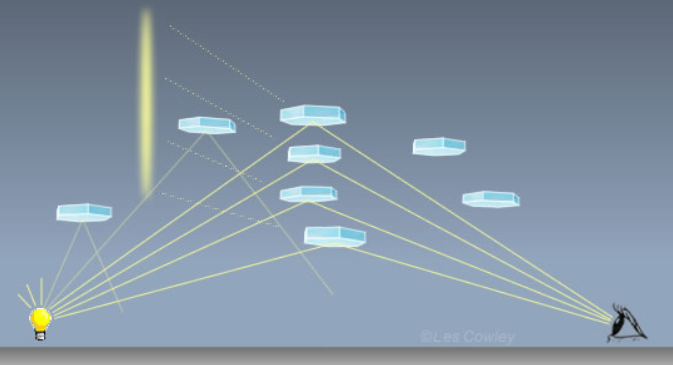Light Pillars
Exploring the Phenomenon of Light Pillars
Light pillars, a captivating atmospheric optical phenomenon, have been observed during extremely cold weather conditions. These mesmerizing columns of light appear to beam directly upwards from unshielded lights, creating a spectacle that captures the imagination. While they may seem otherworldly, light pillars are actually a result of plate-shaped ice crystals suspended in the air close to the ground.
The Nature of Light Pillars
Unlike their natural counterparts found in high clouds, artificial light pillars can reach impressive heights. This is because the rays of light emitted from the lights are not parallel, allowing plate crystals with slight tilts to reflect them downwards. These crystals, responsible for producing the pillars, are typically located approximately halfway between the observer and the light source.
When ice crystals are present in the atmosphere surrounding an individual, light pillars can even be seen around streetlights just a few meters away. This close proximity enhances the visual impact of the phenomenon, adding to its allure.
The Formation of Light Pillars
To understand how light pillars form, it is essential to grasp the role of ice crystals. These plate-shaped crystals possess horizontal facets that reflect light back towards the ground. As millions of these crystals align themselves in the atmosphere, they collectively create the illusion of a column of light extending upwards.
It's important to note that light pillars are not physically located directly above the lights or any other specific point in space. Instead, they are formed by the collection of light beams from the multitude of reflecting ice crystals. This convergence of light creates a stunning visual display for those fortunate enough to witness it.
Height and Appearance
The height of light pillars varies depending on several factors. The altitude at which the ice crystals are suspended in the atmosphere plays a significant role in determining the pillar's stature. Generally, the higher the crystals or the closer the light sources, the taller the pillars appear. In some instances, when the crystals are exceptionally high or the light sources are in close proximity, the pillars seem to radiate from overhead, known as the zenith.
Unlike the crystals responsible for sun pillars, those forming tall artificial light pillars do not require a strong tilt. The column producing these pillars is situated approximately midway between the observer and the light source. This distinction sets artificial light pillars apart from their natural counterparts, allowing for their unique characteristics and appearance.
Capturing the Beauty
For photographers and enthusiasts alike, witnessing and capturing the beauty of light pillars can be a truly rewarding experience. To photograph these ethereal columns of light, it is crucial to consider a few key factors:
- Choose a location with unshielded lights and cold weather conditions.
- Use a tripod to ensure stability and reduce camera shake.
- Adjust camera settings to capture long exposures, allowing for more light to be captured.
- Experiment with different angles and compositions to capture the full grandeur of the phenomenon.
Remember, patience is key when attempting to photograph light pillars. These captivating displays may require some waiting and multiple attempts before achieving the desired shot. However, the end result is often well worth the effort.
Conclusion
Light pillars, a breathtaking atmospheric optical phenomenon, continue to captivate observers worldwide. Understanding their formation and characteristics enhances our appreciation for the wonders of nature. Whether witnessing these pillars in person or capturing them through the lens of a camera, the beauty and intrigue they evoke are sure to leave a lasting impression. So, keep an eye on the sky during those cold winter nights, as you never know when you might be treated to the awe-inspiring sight of light pillars illuminating the darkness.

Multicoloured pillars from low level ice crystals reflecting artificial lights. Shaun Lowe (more of his images) saw these near Bedford Nova Scotia on December '02. ©2002 Shaun Lowe
Columns of light apparently beaming directly upwards from unshielded (and wastefully polluting) lights are sometimes visible during very cold weather. Plate shaped ice crystals, normally only present in high clouds, float in the air close to the ground and their horizontal facets reflect light back downwards.
The pillars are not physically over the lights or anywhere else in space for that matter ~ like all halos they are purely the collected light beams from all the millions of crystals which just happen to be reflecting light towards your eyes or camera.
Artificial light pillars can be much taller than their natural counterparts because rays from the lights are not parallel and plate crystals with small tilts can still reflect them downwards. The crystals producing the pillars are roughly halfway between you and the lights.
When ice crystals float in the air around you, pillars (and other halos) can even be seen around streetlights a few metres away.

Unlike the crystals producing sun pillars, those making tall artificial light pillars need not be strongly tilted. The column producing pillars are approximately midway between the eye and the light source. The higher the crystals in the atmsphere, the taller is the pillar. When the crystals are very high - or the light sources are close - the pillars seem to radiate from overhead, the zenith.
Note: this article has been automatically converted from the old site and may not appear as intended. You can find the original article here.
Reference Atmospheric Optics
If you use any of the definitions, information, or data presented on Atmospheric Optics, please copy the link or reference below to properly credit us as the reference source. Thank you!
-
<a href="https://atoptics.co.uk/blog/light-pillars/">Light Pillars</a>
-
"Light Pillars". Atmospheric Optics. Accessed on April 27, 2024. https://atoptics.co.uk/blog/light-pillars/.
-
"Light Pillars". Atmospheric Optics, https://atoptics.co.uk/blog/light-pillars/. Accessed 27 April, 2024
-
Light Pillars. Atmospheric Optics. Retrieved from https://atoptics.co.uk/blog/light-pillars/.